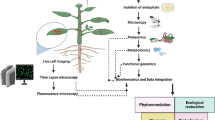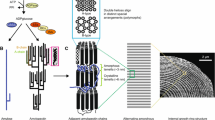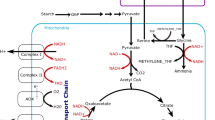Abstract
Diurnal changes in carbohydrates and a broad range of primary metabolites were analysed through a diurnal period in potato leaves (Solanum tuberosum cv. Desiree) using an established gas chromatography-mass spectrometry based metabolic profiling protocol alongside conventional spectrophotometric technologies. In tandem, we profiled transcript levels using both a custom array containing approximately 2,500 cDNA clones predominantly representing transcripts involved in primary metabolism and commercially available arrays containing approximately 12,000 cDNA clones that gave coverage of transcript levels over a broader functional range. The levels of many metabolites and transcripts varied during the diurnal period with 56 significant differences observed in the metabolite contents and 832 significant differences recorded in transcript levels. Whilst a large number of the differences would be expected from what has been known previously, several novel changes were observed in these experiments. Notably, qualitative comparison of the combined data sets obtained from the parallel analysis of transcripts and metabolites suggests relatively few changes in gene expression strongly correlate with changes in metabolite levels during a diurnal cycle. Furthermore, these changes appear to be confined to the central metabolic pathways. However, principal component analysis of the metabolic profiles obtained here revealed that metabolite patterns change progressively through a diurnal period suggesting the operation of mechanisms for tight temporal regulation of metabolite composition.





Similar content being viewed by others
References
Aharoni A, Giri AP, Deuerlein S, Griepink F, de Kogel WJ, Verstappen FWA, Verhoeven HA, Jongsmaa MA, Schwab W, Bouwmeester HJ (2003) Terpenoid metabolism in wild-type and transgenic Arabidopsis plants. Plant Cell 15:2866–2884
Atkin OK, Evans JE, Ball MC, Lambers H, Pons TL (2000) Leaf respiration of snowgum in light and dark: interactions between temperature and irradiance. Plant Physiol 122:915–923
Brandt S, Kloska S, Altmann T, Kehr J (2002) Using array hybridisation to monitor gene expression at the single cell level. J Exp Bot 53:2315–2323
Budde RJA, Randall DD (1990) Pea leaf mitochondrial pyruvate dehydrogenase complex is inactivated in vivo in a light-dependent manner. Proc Natl Acad Sci USA 87:673–676
Carrari F, Nunes-Nesi A, Gibon Y, Lytovchenko A, Ehlers-Lourario M, Fernie AR (2003a) Reduced expression of aconitase results in an enhanced rate of photosynthesis and marked shifts in carbon partitioning in illuminated leaves of Lycopersicon pennellii. Plant Physiol 133:1322–1335
Carrari F, Urbanczyk-Wochniak E, Willmitzer L, Fernie AR (2003b) Engineering central metabolism in crop species: learning the system. Metab Eng 5:191–200
Carrari F, Coll-Garcia D, Schauer N, Lytovchenko A, Palacios-Rojas N, Balbo I, Rosso M, Fernie AR (2005) Deficiency of a plastidial adenylate kinase in Arabidopsis results in elevated photosynthesis amino acid biosynthesis and enhanced growth. Plant Physiol 137:70–82
Chen F, Duran AL, Blount JW, Sumner LW, Dixon RA (2003) Profiling phenolic metabolites in transgenic alfalfa modified in lignin biosynthesis. Pytochemistry 64:1013–1021
Chia T, Thorneycroft D, Chapple A, Messerli G, Chen J, Zeeman SC, Smith SM, Smith AM (2004) A cytosolic glucosyltransferase is required for conversion of starch to sucrose in Arabidopsis leaves at night. Plant J 37:853–863
Colebatch G, Kloska S, Trevaskis B, Freund S, Altmann T, Udvardi MK (2002) Novel aspects of symbiotic nitrogen fixation uncovered by transcript profiling with cDNA arrays. Mol Plant Microbe Interact 15:411–420
Czechowski T, Bari RP, Stitt M, Scheible WR, Udvardi MK (2004) Real-time RT-PCR profiling of over 1400 Arabidopsis transcription factors: unprecedented sensitivity reveals novel root- and shoot-specific genes. Plant J 38:366–379
Draborg H, Villadsen D, Nielsen TH (2001) Transgenic Arabidopsis plants with decreased activity of frustose-6-phosphate,2-kinase/fructose-2,6-bisphosphatase have altered carbon partitioning. Plant Physiol 126:750–758
Fejes E, Nagy F (1998) Molecular analysis of the circadian clock related gene expression in plants: features of the “output” pathways. In: Lumsden PJ, Millar AJ (eds) Biological rythyms and photoperiodism in plants. BIOS Scientific, Oxford, pp 99–118
Fernie AR, Willmitzer L (2004) Carbohydrate metabolism. In: Christou P, Klee HK (eds) The handbook of plant biotechnology. Wiley, Chichester (in press)
Fernie AR, Roscher A, Ratcliffe RG, Kruger NJ (2001) Fructose 2,6-bisphosphate activates pyrophosphate: fructose-6-phosphate 1-phosphotransferase and increases triose phosphate to hexose phosphate cycling in heterotrophic cells. Planta 212:250–263
Fernie AR, Carrari F, Sweetlove LJ (2004) Respiratory metabolism: glycolysis, the TCA cycle and the electron transport chain. Curr Opin Plant Biol 7:254–261
Ferrario-Mery S, Masclaux C, Suzuki A, Valadier MH, Hirel B, Foyer CH (2001) Glutamine and alpha-ketoglutarate are metabolite signals involved in nitrate reductase gene transcription in untransformed and transformed tobacco plants deficient in ferredoxin-glutamine-alpha-ketoglutarate aminotransferase. Planta 213:265–271
Ferrario-Mery S, Hodges M, Hirel B, Foyer CH (2002a) Photorespiration-dependent increases in phosphoenolpyruvate carboxylase, isocitrate dehydrogenase and glutamate dehydrogenase in transformed tobacco plants deficient in ferredoxin-dependent glutamine-alpha-ketoglutarate aminotransferase. Planta 214:877–886
Ferrario-Mery S, Valadier MH, Godefroy N, Miallier D, Hirel B, Foyer CH, Suzuki A (2002b) Diurnal changes in ammonia assimilation in transformed tobacco plants expressing ferredoxin-dependent glutamate synthase mRNA in the antisense orientation. Plant Sci 163:59–67
Fiehn O, Kopka J, Dörmann P, Altmann T, Trethewey RN, Willmitzer L (2000) Metabolite profiling for plant functional genomics. Nat Biotechnol 18:1157–1161
Geigenberger P, Stitt M (2000) Diurnal changes in sucrose, nucleotides, starch synthesis and AGPS transcript in growing potato tubers that are suppressed by decreased expression of sucrose phosphate synthase. Plant J 23:795–806
Geiger DR, Servaites JC (1994) Diurnal regulation of photosynthetic carbon metabolism in C-3 plants. Annu Rev Plant Biol 45:235–256
Girke T, Todd J, Ruuska S, White J, Benning C, Ohlrogge J (2000) Microarray analysis of developing Arabidopsis seeds. Plant Physiol 124:1570–1581
Guo DJ, Chen F, Inoue K, Blount JW, Dixon RA (2001) Downregulation of caffeic acid 3-O-methyltransferase and caffeoyl CoA 3-O-methyltransferase in transgenic alfalfa: impacts on lignin structure and implications for the biosynthesis of G and S lignin. Plant Cell 13:73–88
Harmer SL, Hogenesch LB, Straume M, Chang HS, Han B, Zhu T, Wang X, Kreps JA, Kay SA (2000) Orchestrated transcription of key pathways in Arabidopsis by the circadian clock. Science 290:2110–2113
Howles PA, Sewalt VJH, Paiva NL, Elkind Y, Bate NJ, Lamb C, Dixon RA (1996) Overexpression of L-phenylalanine ammonia-lyase in transgenic tobacco plants reveals control points for flux into phenylpropanoid biosynthesis. Plant Physiol 112:1617–1624
Kruger NJ (1997) Carbohydrate synthesis and degradation. In: Dennis DT, Turpin DH, Lefebvre DD, Layzell DB (eds) Plant Metabolism. Longman, Harlow, pp 83–104
Lu Y, Sharkey TD (2004) The role of amylomaltase in maltose metabolism in the cytosol of photosynthetic cells. Planta 218:466–473
Lytovchenko A, Bieberich K, Willmitzer L, Fernie AR (2002a) Carbon assimilation and metabolism in potato leaves deficient in plastidial phosphoglucomutase. Planta 215:802–811
Lytovchenko A, Sweetlove LJ, Pauly M, Fernie AR (2002b) The influence of cytosolic phosphoglucomutase on photosynthetic carbohydrate metabolism. Planta 215:1013–1021
Masclaux-Daubresse C, Valadier MH, Carrayol E, Reisdorf-Cren M, Hirel B (2002) Diurnal changes in the expression of glutamate dehydrogenase and nitrate reductase are involved in the C/N balance of tobacco source leaves. Plant Cell Environ 25:1451–1462
Matt P, Schurr U, Klein D, Krapp A, Stitt M (1998) Growth of tobacco in short-day conditions leads to high starch, low sugars, altered diurnal changes in the Nia transcript and low nitrate reductase activity, and inhibition of amino acid synthesis. Planta 207:27–41
Matt P, Geiger M, Walch-Liu P, Engels C, Krapp A, Stitt M (2001) The immediate cause of the diurnal changes of nitrogen metabolism in leaves of nitrate-replete tobacco: a major imbalance between the rate of nitrate reduction and the rates of nitrate uptake and ammonium metabolism during the first part of the light period. Plant Cell Environ 24:177–190
Matt P, Krapp A, Haake V, Mock HP, Stitt M (2002) Decreased Rubisco activity leads to dramatic changes of nitrate metabolism, amino acid metabolism and the levels of phenylpropanoids and nicotine in tobacco antisense RBCS transformants. Plant J 30:663–677
Müller C, Scheible WR, Stitt M, Krapp A (2001) Influence of malate and 2-oxoglutarate on the NIA transcript level and nitrate reductase activity in tobacco leaves. Plant Cell Environ 24:191–203
Murashige T, Skoog F (1962) A revised medium for rapid growth and bioassays with tobacco tissue cultures. Physiol Plantarum 15:473–497
Niittyla T, Messerli G, Trevisan M, Chen J, Smith AM, Zeeman SC (2004) A previously unknown maltose transporter essential for starch degradation in leaves. Science 303:87–89
Piechulla B (1988) Plastid and nuclear mRNA fluctuations in tomato leaves—diurnal and circadian rhythms during extended dark and light periods. Plant Mol Biol 11:345–353
Raghavendra AS, Padmasree K (2003) Beneficial interactions of mitochondrial metabolism with photosynthetic carbon assimilation. Trends Plant Sci 8:546–553
Roessner U, Luedemann A, Brust D, Fiehn O, Linke T, Willmitzer L, Fernie AR (2001) Metabolic profiling allows comprehensive phenotyping of genetically or environmentally modified plant systems. Plant Cell 13:11–29
Roessner-Tunali U, Hegemann B, Lytovchenko A, Carrari F, Bruedigam C, Granot D, Fernie AR (2003) Metabolic profiling of transgenic tomato plants overexpressing hexokinase reveals that the influence of hexose phosphorylation diminishes during fruit development. Plant Physiol 133:84–99
Scheible W-R, Gonzalez-Fontes A, Morcuende R, Lauerer M, Geiger M, Glaab J, Gojon A, Schulze ED, Stitt M (1997) Tobacco mutants with a decreased number of functional nia genes compensate by modifying the diurnal regulation of transcription, post-translational modification and turnover of nitrate reductase. Planta 203:304–319
Scheible W-R, Krapp A, Stitt M (2000) Reciprocal diurnal changes of phosphoenolpyruvate carboxylase expression and cytosolic pyruvate kinase, citrate synthase and NADP-isocitrate dehydrogenase expression regulate organic acid metabolism during nitrate assimilation in tobacco leaves. Plant Cell Environ 23:1155–1168
Scott P, Kruger NJ (1995) Influence of elevated fructose-2,6-bisphosphate levels on starch mobilization in transgenic tobacco-leaves in the dark. Plant Physiol 108:1569–1577
Scott P, Lange AJ, Kruger NJ (2000) Photosynthetic carbon metabolism in leaves of transgenic tobacco (Nicotiana tabacum L.) containing decreased amounts of fructose 2,6-bisphosphate. Planta 211:864–873
Stitt M (1990) The flux of carbon between the chloroplast and the cytoplasm. In: Dennis DT, Turpin DH (eds) Advanced plant physiology: interaction and control of metabolism. Pitman, London, pp 319–340
Stitt M, Fernie AR (2003) From measurements of metabolites to metabolomics: an ‘on the fly’ perspective illustrated by recent studies of carbon–nitrogen interactions. Curr Opin Biotech 14:136–144
Strand A, Zrenner R, Trevanion S, Stitt M, Gustafsson P, Gardeström P (2000) Decreased expression of two key enzymes in the sucrose biosynthesis pathway, cytosolic fructose-1,6-bisphosphate and sucrose phosphate synthase, has remarkably different consequences for photosynthetic carbon metabolism in transgenic Arabidopsis thaliana. Plant J 23:759–770
Thain SC, Murtas G, Lynn JR, McGrath RB, Millar AJ (2002) The circadian clock that controls gene expression is tissue specific. Plant Physiol 130:102–110
Thimm O, Essigmann B, Kloska S, Altmann T, Buckhout TJ (2001) Response of Arabidopsis to iron deficiency stress as revealed by microarray analysis. Plant Physiol 127:1030–1043
Thimm O, Blässing O, Gibon Y, Nagel A, Meyer S, Krüger P, Selbig J, Müller LA, Rhee SY, Stitt M (2004) MAPMAN: a user-driven tool to display genomics data sets onto diagrams of metabolic pathways and other biological processes. Plant J 37:914–939
Trethewey RN, Krotzky AJ, Willmitzer L (1999) Metabolic profiling: a Rosetta Stone for genomics?. Curr Opin Plant Biol 2:83–85
Urbanczyk-Wochniak E, Luedemann A, Kopka J, Selbig J, Roessner-Tunali U, Willmitzer L, Fernie AR (2003) Parallel analysis of transcript and metabolic profiles: a new approach in systems biology. EMBO Rep 4:989–993
Van der Hoeven R, Ronning C, Giovannoni J, Martin G, Tanksley S (2002) Deductions about the number, organization, and evolution of genes in the tomato genome based on analysis of a large expressed sequence tag collection and selective genomic sequencing. Plant Cell 14:1441–1456
Weise SE, Weber AP, Sharkey TD (2004) Maltose is the major form of carbon exported from the chloroplast at night. Planta 218:474–482
Winter H, Huber SC (2000) Regulation of sucrose metabolism in higher plants: localization and regulation of activity of key enzymes. Crit Rev Biochem Mol 35:253–289
Zhu T (2003) Global analysis of gene expression using GeneChip microarrays. Curr Opin Plant Biol 6:418–425
Acknowledgements
We thank Drs Helen Jenner and Natalia Palacios-Rojas for discussion on aspects of secondary metabolism. Equally deep discussion of various aspects of transcript data with Drs Oliver Bläsing and Oliver Thimm is gratefully acknowledged. We are also thankful to Helga Kulka for excellent care of the plants. LJS acknowledges the financial support of the BBSRC, UK. EU-W and ARF acknowledges the financial support of the Max Planck Society.
Author information
Authors and Affiliations
Corresponding author
Rights and permissions
About this article
Cite this article
Urbanczyk-Wochniak, E., Baxter, C., Kolbe, A. et al. Profiling of diurnal patterns of metabolite and transcript abundance in potato (Solanum tuberosum) leaves. Planta 221, 891–903 (2005). https://doi.org/10.1007/s00425-005-1483-y
Received:
Accepted:
Published:
Issue Date:
DOI: https://doi.org/10.1007/s00425-005-1483-y




